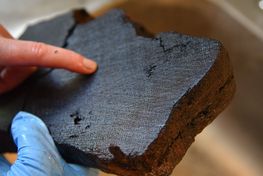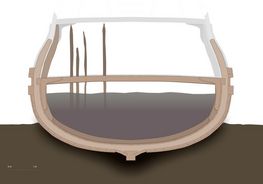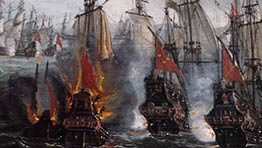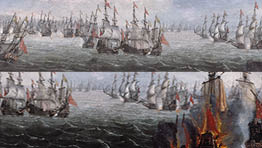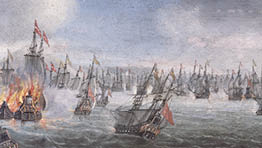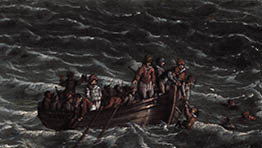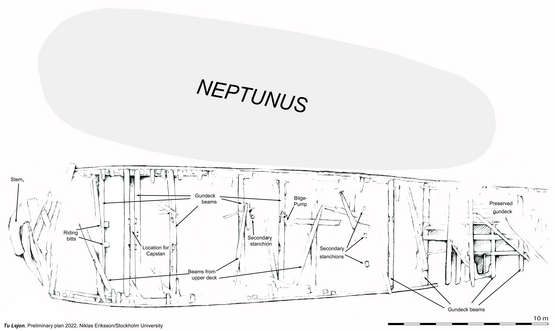
Neptunus and Tu Løver: Identification of Danish ships in Stockholm’s Harbour – archaeology, dendrochronology and archives
By: Aoife Daly, Associate Professor, The Saxo Institute, University of Copenhagen
Niklas Eriksson, Associate Professor, Dept of Archaeology and Classical Studies, Stockholm University
Jim Hansson, Curator, Archaeology Unit, Swedish National Maritime and Transport Museums
Ten valuable prizes were taken by the Swedes during the battle of Femern, including Neptunus and Tu Løver. These prizes were incorporated into the Swedish navy and appear in the written sources from the following years. In 1658 – thirty years after the keel of this ship was stretched at Balfours shipyard in Christianshavn, Tu Løver appears in the sources as a fireship. This was usually one of the last chapters in the story of a sailing warship’s life and means that the majority of the ship’s guns were removed, and the hull was filled with inflammable material and aimed to set enemy ships on fire. However, Tu Løver did not end up in flames, and the following year the Swedish Admiralty had other plans for the ageing hull.
Archaeological survey
During the spring 2021 two wrecks at Myttingeviken, outside Stockholm, both of which are substantially preserved, have been archaeologically surveyed. The fieldwork was carried out as part of the research programme ‘Lost navy’ Sweden's "blue" heritage c. 1450- 1850’. The archaeological survey was concentrated on Tu Løver and resulted in measuring and documentation of the hull and of construction details. The profile in the middle of the ship was photographed and resulted in a 3D model, to reconstruct the shape of the hull. The widest part of the hull is 8.5 m between the inside planking. The length of the ship is about 34-35 m. The length of the keel is estimated to 26 m. It was also possible to estimate the draught. From the lowest wale to underneath the keel it is 2.6 m.
Remarkably, a number of secondary timbers were found, standing straight up in the hull. These are clear evidence of the preparation before sinking. The idea was that after two ships were placed on the seabed another should be placed on top. The timbers’ function must have been to support the upper deck beams when another ship was laid down on top. Clearly this was a fascinating site.
The archives
The short reign of Swedish king Karl X Gustav (reigned 1654-1660) was dominated by war and the already existing fortifications at Vaxholm along the sea route to Stockholm were strengthened. The Vaxholm archipelago offers several alternative passages and the passage at Oxdjupet, which is over 30 meters deep, provided the greatest challenge for blockage. A large number of the old ships have ended up here on the seabed and the intention was that Tu Løver should find its last resting place here as well.
In order to fill up the passage it was necessary to place the ships on top of each other. Two ships Göteborg and Netterbladet (also a prize ship taken in 1644 from Denmark) were to be sunk in Oxdjupet in 1656, but the ships were separated from each other and ended up drifting in the wrong direction. In 1659 then, a new attempt was commissioned, and two other ships were prepared.An engineer Vijkman declared in October that year that both vessels were ready to be sunk.; ‘but he had to wait for the His Excellences The Council of State and the Chambers President own […] presence when this will be carried out’. Vijkman ensures that it is ‘a great work’.
In the same minutes, Admiral Richard Clerk expresses his concern over the project and that it is urgent, as it was now late in the autumn, bad weather and storms could hazard the entire project. His fears came true: on a meeting on the 17 November, it is stated that the two ships had come loose in a storm during the night and drifted away into the nearby bay ‘where they have sunk themselves’.
Among the most renowned vessels, that the former Scottish Master Shipwright David Balfour built for King Christian IV, is the small warship Hummeren, launched in 1624. No less than eight other ships were built using Hummeren as a template even if the majority of these were slightly enlarged versions of the original design. The drawing for Hummeren is preserved in the Danish Rigsarkiv and is one of the oldest constructional drawings that exists.
At the Battle of Femern seven of the ships based on the Hummeren design were in use. All except Sorte Rytter participated in the battle but only one Lammet (the Lamb) returned to Copenhagen. Four of these ships – Tre Løver, Stormarn, Tu Løver and Cronet Fisk were taken by the Swedes.The last one, Delmenhorst was set on fire.
It was Tu Løver that was nailed together with another Danish Prize from Femern, the small ship Neptunus to block the channel at Oxdjupet in 1659.
The dendrochronological investigation
Samples for dendrochronological analysis were extracted from timbers from both wrecks. By measuring the tree-rings we can find out when the trees for the ships were felled. Furthermore, we can identify where the trees, used to build these ships, had grown.
It has frequently been demonstrated that acquisition of timber for shipbuilding in Northern Europe, by the 17th century, is a complicated endeavour. Batavia, a ship built in Amsterdam in 1628, by the Dutch East India Company, that wrecked on her first voyage off the Western Australian coast, has been shown to have been built of timber from at least three widely different sources. This is perhaps not so surprising, as the Low Countries suffered from timber shortage much earlier. It is more surprising that Vasa, built in Stockholm in the same year as Batavia, was also built of timber from a variety of sources. Sweden had its own timber resources, including availability of large oak trees, but nevertheless imported timber from further afield.
The same pattern of timber transport is also apparent in the Danish region. Timbers for waterfront structures in Copenhagen, from the early and mid-16th centuries, were sourced on the now Swedish side of the Øresund, which was still under the Danish Crown. By the mid-17th century, Denmark was using Norwegian timber sources for similar building needs.
How then do the dendrochronological results in this analysis help to confirm or disprove whether the two ships at Myttingeviken indeed are the remains of the Danish-owned ships, Neptunus and Tu Löver, captured at the Battle of Femern?
Eight samples from the smaller ship tell us that trees for this ship were felled around AD 1629-1636. The dates for the larger ship give a felling estimate around AD 1608-1622. Thus, in terms of their chronology, these two wrecks clearly represent ships built before 1644, the year the Battle at Femern took place.
In terms of the region of origin of the timber used for these ships, the results are not as clear-cut. Diverse timber sources were utilised for both ships. The five dated timbers from the larger ship suggest that it was built from timbers from Southern Scandinavia and northern Germany, which would fit very well with a ship built in Denmark. The timbers from the smaller ship indicate that timber was sourced further westwards towards The Low Countries.
The combined evidence
According to the contract books in the Danish national archive (Dk. Rigsarkiv), the building of Tu Løver was delayed due to shortage of material. Timber was thus gathered from both sides ofØresund. The dendrochronology of the larger ship at Myttingeviken would fit well with this detail.According to a letter shortly after the battle, from Swedish Admiral Carl Gustaf Wrangels, Neptunus was brand new when the Swedes took the ship; King Christian IV had brought it in Holland the year before. This would also fit very well with the dendrochronological dating and the source of the timber. For the larger ship surveyed at Myttingeviken, the result of the reconstructed profile is almost identical to Hummeren. The shape of the hull and the measurements estimated from the reconstruction also shows very convincing similarities to the blueprints and dimensions of Hummeren. Together with sources in the Swedish Military Archives, that mention that the two ships were nailed together and that they came loose and ‘sank themselves’, we can be quite certain that it is indeed the two Danish prizes from Femern that rest on the muddy seabed in Myttingeviken outside Stockholm.
Read more
Bellamy, M. 2005. Christian IV and His Navy: A Political and Administrative History of the Danish Navy 1596-1648. Brill.
Daly, A. 2021. Timber supply for Vasa: new discoveries. Open Sea, Closed Sea: Local Traditions and Inter-regional Traditions in Shipbuilding: Proceedings of the Fifteenth International Symposium on Boat and Ship Archaeology (ISBSA 15), Marseille 2018. Paris: CNRS Editions, Archaeonautica 21; 2021. Fifteenth International Symposium on Boat and Ship Archaeology (ISBSA15), Marseille. https://doi.org/10.5281/zenodo.5575312
Daly A., Domínguez-Delmás M., van Duivenvoorde W. 2021. Batavia shipwreck timbers reveal a key to Dutch success in 17th-century world trade. PLoS ONE 16(10): e0259391. https://doi.org/10.1371/journal.pone.0259391
Eriksson, N. forthcoming (2022). David Balfours ‘skabelon’ and the ship Tu Løver 1631-1659: Historical archaeology between text, shipwreck and a constructional drawing.
